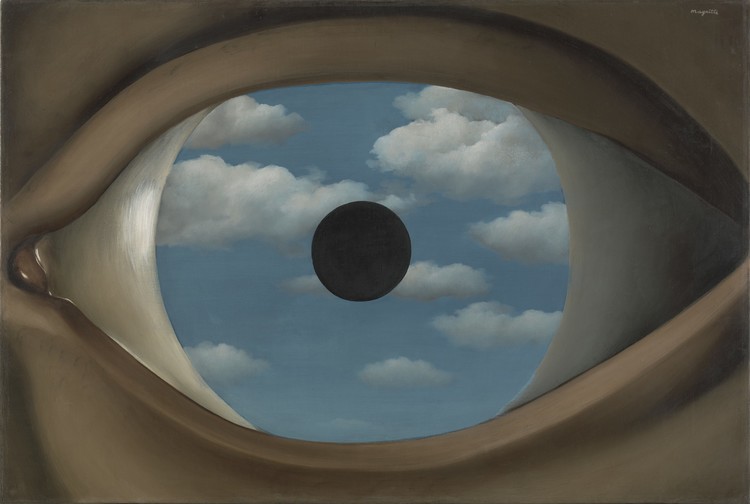


By Steve Sailer
05/07/2008
Short answer: No.
But, a lot of people suspect it is, so it’s worth exploring the question.
In 1993, I attended the enormously popular exhibition at the formidable Chicago Art Institute of the paintings of the Belgian Rene Magritte, a commercial artist in dreary Brussels who did witty Surrealist paintings in his off-hours.
After listening to a lecture on Magritte by the curator of exhibition, I approached her and told her how much more popular Magritte had gotten in just 17 years. In 1976 I'd visited a major exhibition of Magritte’s work at the museum of Rice University in Houston, which, at the time, consisted of two quonset huts made of corrugated metal out in the football stadium parking lot. Almost nobody was there.
(It wasn’t that Magritte was unpopular in the 1970s — the famous cover picture for Jackson Browne’s 1974 "Late for the Sky" album was a Los Angelesized-version of a well-known Magritte painting. Instead, he was a little too popular for artistic prestige, like M.C. Escher. In the late 1970s, Magritte’s paintings inspired album covers by Styx and Gary Numan, which probably did more for his popularity than his prestige.)
And then I asked the poor curator the kind of uncomfortable question that has led me to stop going out in public: "So, if Magritte can climb so much in prestige, can we expect to attend an M.C. Escher retrospective at the Art Institute in a few decades?"
Her face clouded over with consternation. She began to explain that new research into Magritte’s life recently discovered that he hadn’t spent all his life in boring Brussels, but had actually spent 1927-30 in Paris, where he became friends with the leading artists of the day. And then she stopped, and said, "I don’t want to make it sound like being a famous artist is all about who you know … " And then she stopped again, because that’s exactly what it sounded like. I made some encouraging noises to assure her that I'd never dream such a thing, and she got back on track.
The point is of course that who you know is important in the history of art … because history needs a story.
Why is Picasso’s Bull’s Head a famous work of art, while the similar Bull’s Heads no doubt created earlier by random junkyard proprietors and bicycle shop employees and the like are not famous works of art? Because, of course, Picasso’s was created by a famous artist.
And that leads to the question: Why is Picasso a famous artist? And it’s very tempting to answer: Because he created famous works of art, like Bull’s Head.
Yet, the real answer is: Because he influenced other great artists.
And how do we know they are great artists? Because they influenced other great artists. And how do we know these other great artists are …
You can see the potential for circular reasoning here.
And, yet, I'd caution against too much cynicism about the received history of art. It is what it is — a story of who influenced whom — for a reason. Scholars can’t just make it up, at least not all of it. It’s artists who ultimately get to decide who their greatest predecessors were, not the critics and historians.
For example, consider the pre-Renaissance Florentine painter Giotto. Is Giotto’s inclusion in the history books justified? Well, Giotto influenced Masaccio who influenced Leonardo who influenced Raphael who influenced Caravaggio who influenced Rubens who influenced Van Dyck, so, yes, Giotto is most definitely important. It’s not all a huge con game. You can fool all the people some of the time and some of the people all the time, but you definitely can’t fool Masaccio, Leonardo, Raphael, Caravaggio, Rubens, and Van Dyck all the time.
Conversely, in Victorian times, John Ruskin, perhaps the most influential critic ever, wrote the early Baroque Carraci family out of the history of painting, but they've slowly returned since there is too much objective evidence of their influence on later major painters to permanently ignore them.
The big problem, though, is that, after the development of photography, objective skill declined in importance as a measure of the artist and conceptual cleverness rose in ranking. So, the chances have increase for plausible-sounding critics and scholars to drive art history off track and into the trackless wastes of Art Theory.
For example, the rise in recent years in art history textbooks of jokester Marcel Duchamp as the key figure of 20th Century art reflects what happens when art writers' theorizing becomes untethered from actual artistic skill. For example, Wikipedia informs us: "In December 2004, Duchamp’s Fountain was voted the most influential artwork of the 20th century by 500 well-established artists and critics in the British art world." Fountain is a urinal.

It’s easy to write about Duchamp, who produced more epigrams and conceptual jests than actual works of visible art. And you can’t reality-check Duchamp’s influence on the major artists of the 21st Century, since there aren’t any major artists of the 21st Century.
So, most of the written history of art, from Vasari onward, is not a hoax, but the closer we get to the present, the less we can say that with any confidence.